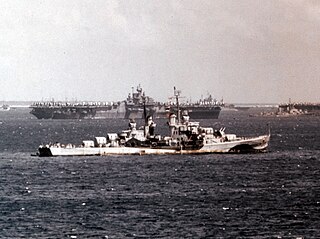Sources
- This article incorporates text from the public domain Dictionary of American Naval Fighting Ships .The entry can be found here.
Five United States Navy ships have borne the name Atlanta, after the city of Atlanta, Georgia:
Three ships of the United States Navy have borne the name Brooklyn, after the New York City borough of Brooklyn.
Two ships of the United States Navy have borne the name Boise, after Boise, Idaho.
Multiple ships of the United States Navy have been named USS Newark, after the city of Newark, New Jersey.
Five ships of the United States Navy have been named Buffalo, the first after the large mammal, the others after the city of Buffalo, New York.
USS Amsterdam may refer to either of two U.S. Navy ships named for Amsterdam, New York:
Four ships of the United States Navy have been named Astoria, after the town of Astoria, Oregon.
Three ships of the United States Navy have been named USS Denver, after the city of Denver, Colorado.
Three ships of the United States Navy have been named USS Juneau, after the city of Juneau, Alaska:

USS Juneau (CL-52) was a United States Navy Atlanta-class light cruiser sunk at the Naval Battle of Guadalcanal 13 November 1942. In total, 687 men, including the 5 Sullivan brothers, were killed in action as a result of her sinking. She was laid down by Federal Shipbuilding Company, Kearny, New Jersey, on 27 May 1940, launched on 25 October 1941, sponsored by Mrs. Harry I. Lucas, wife of the mayor of the city of Juneau, Alaska, and commissioned on 14 February 1942, with Captain Lyman K. Swenson in command. She was torpedoed and sank on 13 November 1942, with only 10 survivors rescued after 8 days in the water. To honor the five Sullivan brothers, who all died in the sinking, and the Juneau, the Navy later commissioned two ships named The Sullivans and two ships named Juneau. On 17 March 2018, the wreck of Juneau was located by Paul Allen's research crew on board RV Petrel at a depth of about 4,200 m (13,800 ft) off the coast of the Solomon Islands.
USS Norfolk may refer to:
Three ships of the United States Navy have been named Birmingham, after the city of Birmingham, Alabama.
Four ships of the United States Navy have been named Chattanooga, after the city of Chattanooga, Tennessee.
USS Fargo has been the name of two ships of United States Navy, the first of which was not completed as originally planned. Hence, there has been only one commissioned ship named for the city of Fargo, North Dakota.
Five ships of the United States Navy have been named USS Cincinnati, after the city of Cincinnati, Ohio.
Five ships of the United States Navy have been named USS Helena, after the city of Helena, Montana, though only four were completed.

USS Flint (CL-97) was a modified Atlanta-class light cruiser, sometimes referred to as an "Oakland-class". She was named after the city of Flint, Michigan. She was launched on 25 January 1944 by Bethlehem Shipbuilding Corporation of San Francisco, California, sponsored by Mrs. R. A. Pitcher. She was and commissioned on 31 August 1944. She was reclassified CLAA-97 on 18 March 1949.

The second USS Fresno (CL-121) was a United States Navy Juneau-class light cruiser launched on 5 March 1946 by Federal Shipbuilding and Dry Dock Company of Kearny, New Jersey, sponsored by Mrs. Ruth R. Martin; and commissioned on 27 November 1946, with Captain Elliott Bowman Strauss in command. She was reclassified CLAA-121 on 18 March 1949.

Norman (Nicholas) Scott was a rear admiral in the United States Navy, and was one of only two U.S. Navy admirals killed in action during a surface battle in World War II. He was one of five flag officers of the U.S. Navy to die in World War II, the others being Isaac C. Kidd, Daniel J. Callaghan, Henry M. Mullinnix, and Theodore E. Chandler.

USS Vicksburg may refer to the following ships of the United States Navy:

The Juneau-class cruisers were United States Navy light cruisers that were modified version of the Atlanta-class cruiser design. The ships had the same dual-purpose main armament as USS Oakland with a much heavier secondary antiaircraft battery, while the anti-submarine depth charge tracks and torpedo tubes were removed along with a redesigned superstructure to reduce weight and increase stability. Three ships were ordered and built, all completed shortly after World War II, but only Juneau remained active long enough to see action during the Korean War.